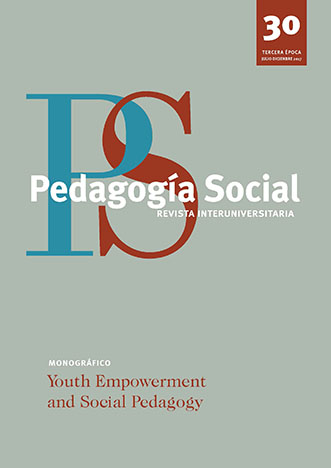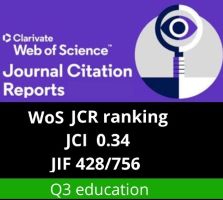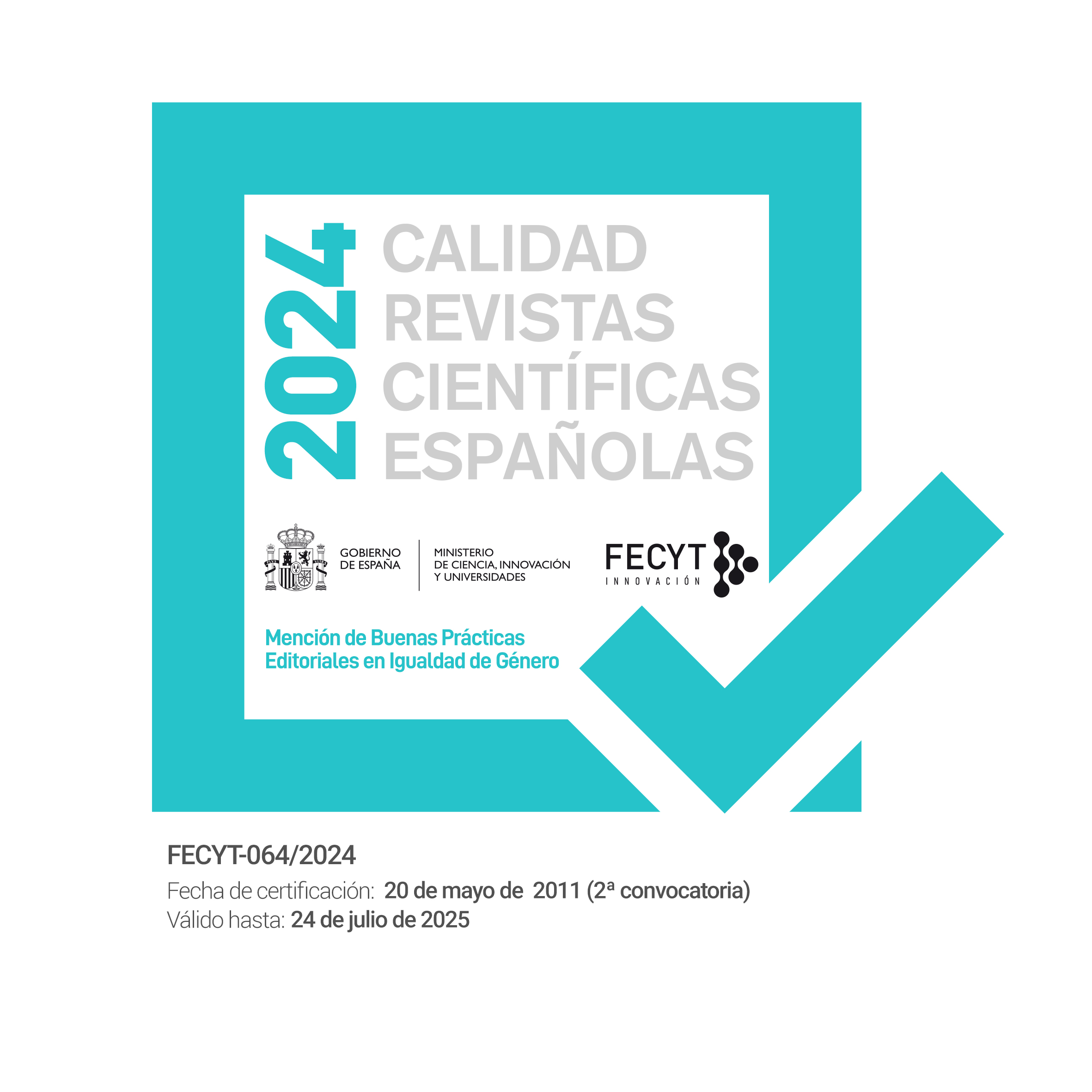Youth perception on spaces and moments in the process of empowerment. A quantitative approach
DOI:
https://doi.org/10.7179/PSRI_2017.30.04Keywords:
Youth empowerment, empowering spaces, critical incidents, life stagesAbstract
The voice of youth has not been taken into account in the conceptualization of empowerment and related research. The contents of this article contribute to the study of spaces and key moments in the process of youth empowerment through first-person experi¬ences of 890 young. A quantitative approach will be used in order to consider the contribu¬tion of specific ambits of everyday life to capacity development and its application. Personal experiences perceived by youth as highly empowering are identified, and the relationship between empowerment and different life stages is studied. The findings suggest that the spac¬es generating more youth empowerment are formal and non-formal education settings and work environment. The importance of emancipation and life experiences entailing personal overcoming is also illustrated. In essence, the outcomes provide evidence and contribute to the debate and reflection of youth empowerment so as to promote future research and im¬prove youth work interventions, as well as the design and implementation of youth policiesDownloads
References
Blanchet-Cohen, N., & Brunson, L. (2014). Creating Settings for Youth Empowerment and Leadership: An Ecological Perspective, Child & Youth Services, 35 (3), 216-236, DOI: 10.1080/0145935X.2014.938735.
Boluijt, B., & de Graaf, L. J. (2010). Preaching empowerment, practicing participation: The use of empowerment and citizen participation in Dutch local democracies. Onbekend: Tilburgse School voor Politiek en Bestuur (TSPB).
Fetterman, D. M., & Wandersman, A. (2007). Empowerment Evaluation: Yesterday, Today, and Tomorrow. American Journal of Evaluation 28 (2), 179-98. doi:10.1177/1098214007301350.
Hennink, M., Kiiti, N., Pillinger, M., & Jayakaran, R. (2012). Defining empowerment: perspectives from international development organisations. Development in Practice, 22 (2), 202-215. Holte-McKenzie, M.; Forde, S. & Theobald, S. (2006). Development of a Participatory Monitoring and Evaluation Strategy. Evaluation and program planning, 29 (4), 365-76.
Jennings, L. B., Parra-Medina, D. M., Hilfinger Messias, D. K., & McLoughlin, K. (2008). Toward a critical social theory of youth empowerment. Journal of Community Practice, 14, 31-55.
Kaplan, S. J., L. Skolnik, L., & Turnbull, A. (2009). Enhancing the Empowerment of Youth in Foster Care: Supportive Services. Child Welfare, 88 (1), 133-161.
Kelly, C., & Carson, E. (2012). The Youth Activist Forum: Forging a Rare, Disability-Positive Space That Empowers Youth. Journal of Youth Studies 15 (8), 1089-1106. doi:10.1080/13676261.2012.693595.
Masa, M. (2009). Adolescentes en Euskadi. Una aproximación desde el empoderamiento. Vitoria-Gasteiz: Emakunde. Instituto Vasco de la Mujer.
Mchale, S. M., Dotterer, A., & Kim, J.-Y. (2009). An ecological perspective on the Media and Youth Development. American Behavioral Scientist, 52 (8), 1186-1203.
Morrissey, J. (2000). Indicators of Citizen Participation: Lessons from Learning Teams in Rural EZ/EC Communities. Community Development Journal, 35 (1), 59-74.
Morton, M. H., & Montgomery, P. (2013). Youth Empowerment Programs for Improving Adolescents’ Self-Efficacy and Self-Esteem: A Systematic Review. Research on Social Work Practice, 23 (1), 22-33.
Mosedale, S. (2003). “Towards a framework for assessing empowerment”. Paper presented at the Conference New Directions in Impact Assessment for Development. Methods and Practice, Manchester, November 24-25.
Nolas, S-M. (2014). Exploring Young People’s and Youth Workers’ Experiences of Spaces for ‘youth Development’: Creating Cultures of Participation. Journal of Youth Studies, 17 (1), 26-41. Doi:10.1080/13676261.2013.793789.
Observatori Català de la Joventut. (2016). Situació laboral de les persones joves a Catalunya. Generalitat de Catalunya. Departament de Treball, Afers Socials i Famílies. Direcció General de Joventut.
Omar, A., Paris, L., Delgado, H. U., Ameida da Silva, S. E., & Aguiar de Souza, M. (2011). Un modelo explicativo de resiliencia en jóvenes y adolescentes. Psicologia Em Estudo, 16 (2), 269-277.
Pearrow, M. M. (2011). Opportunity for Unity Collaborative: Building Healthy Communities by Empowering Young Adults. Community Development 42 (2), 167-80.
Peterson, N. A. (2014). Empowerment theory: clarifying the nature of higher-order multidimensional constructs. American Journal of Community Psychology 53 (1-2), 96-108.
Peterson, N. A., Peterson, C. H., Agre, L., Christens, B. D., & Morton, C. M. (2011). Measuring youth empowerment: validation of a Sociopolitical Control Scale for Youth in an urban community context. Journal of Community Psychology, 39 (5): 592-605. Doi:10.1002/jcop.20456.
Pick, S., Sirkin, J., Ortega, I., Osorio, P., Martínez, R., Xocolotzin, U., & Givaudan, M. (2007). Escala Para Medir Agencia Personal y Empoderamiento (ESAGE). Revista Interamericana de Psicología, 41 (3), 295-304.
Pineda-Herrro, P., Agud-Morell, I., Ciraso-Cali, A., & Soler-Masó, P. (en revisión). In their own words: Elements of Youth Empowerment in Spain. Journal of Youth Studies.
Pineda-Herrero, P., Agud-Morell, I., & Núñez, H. (2015). Empoderamiento juvenil: conceptos y significados del empoderamiento para sus protagonistas. IV Congreso Iberoamericano de Pedagogía Social. Ciudad de Puebla, México.
Russell, S. T., Muraco, A., Subramaniam, A., & Laub, C. (2009). Youth empowerment and high school gay-straight alliances. Journal of Youth and Adolescence, 38 (7), 891-903. Doi:10.1007/s10964-008-9382-8.
Sathar, Z.A., & Kazi, S. 1997. Women’s Autonomy, Livelihood & Fertility: A Study of Rural Punjab. Islamabad: Instituto Pakistan Institute of Development Economics.
Soler, P., Trilla, J., Jiménez-Morales, M., & Úcar, X. (2017). La construcción de un modelo educativo del empoderamiento juvenil: espacios, momentos y procesos, Pedagogía Social. Revista Interuniverstiaria, 30, 25-40. DOI:10.7179/ PSRI_2017.30.02.
Stolte, L. C., Isenbarger, M., & Cohen, A. K. (2014). Measuring Civic Engagement Processes and Youth Civic Empowerment in the Classroom: The CIVVICS Observation Tool, The Clearing House: A Journal of Educational Strategies, Issues and Ideas, 87:1, 44-51, DOI: 10.1080/00098655.2013.842531.
Tromp, M. (2007). A system of empowerment indicators for a corporate work environment. Johannesburg: University of Johannesburg.
Úcar Martínez, X., Jiménez-Morales, M., Soler Masó, P., & Trilla, J. (2016). Exploring the conceptualitzation and research of empowerment in the field of youth. International Journal of Adolescence and Youth. Doi: http://dx.doi.org/10.10 80/02673843.2016.1209120
Wagaman, M. A. (2011). Social Empathy as a Framework for Adolescent Empowerment. Journal of Social Service Research 37 (3), 278-293.
Wright, K. (2010). “Giving Voice’ to Youths in Out-of-Home Placements. Journal of Human Behavior in the Social Envi-ronment, 20 (3), 335-348.
Downloads
Additional Files
Published
Issue
Section
License
Copyright (c) 2017 Pedagogía Social. Revista Interuniversitaria

This work is licensed under a Creative Commons Attribution-NonCommercial-ShareAlike 4.0 International License.
Copyright and right to archive
The published version of the articles can be self-archived by their authors in open access institutional and thematic repositories. However, Pedagogía Social. Revista Interuniversitaria must authorize partial or global reutilisation on new papers or publications.
Published papers must be cited including the title of the journal Pedagogía Social. Revista Interuniversitaria, issue, pages and year of publication
Ethical responsibilities
Pedagogía Social. Revista Interuniversitaria does not accept any material that has been previously published in other documents or publications. Authors are responsible for obtaining the required permissions for partial or global reproduction any material from other publications, and to correctly quote its origin.
Pedagogía Social. Revista Interuniversitaria is obliged to detect and report fraudulent practices.
Only those who have intellectually contribute to the development of the paper must appear as authors.
The journal expects authors to declare any commercial partnership that might entail a conflict of interest with respect to the submitted article.
Authors must mention in the article, preferably in the “methodology” section, that the procedures used during the samplings and controls have been made after getting informed consent.
The journal will not use any received contribution in a way other than the goals described in these guidelines.
Copyright Notice
© Pedagogía Social. Revista Interuniversitaria. Papers published in both the printed and online versions of this Journal are property of Pedagogia Social. Revista Interuniversitaria, being required to cite the source in any partial or total reproduction.
Unless otherwise stated, all content of this electronic journal is distributed under "Creative Commons Attribution-Non commercial 3.0 Spain" (CC-by-nc) license for use and distribution. The informative version and the legal text of this license is available here. This has to be expressly stated in this way when necessary.






